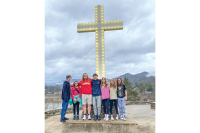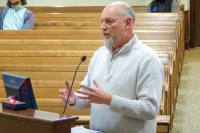WCU to exhibit contemporary photos of Appalachia
The changing face of Appalachia is the subject of an upcoming photography exhibit at the Fine Art Museum at Western Carolina University.
“Seeing Rural Appalachia,” large-format photographs by Mike Smith, will run Sunday, Oct. 24, through Friday, Dec. 17. The public is invited to a free reception beginning at 2 p.m. Oct. 24.
Smith’s photographs expose the human impact on the landscape, from aged, weather-softened farm buildings that seem to be an organic part of the landscape to the jarring reality of big, bright, new gas stations. His photographs of rural Tennessee show the lush beauty of the land while they reveal the suburban encroachment that threatens much of rural Appalachia. This exhibit collects Smith’s work from the past five years.
“The natural mountain landscape immediately made a profound impression on me when I arrived in East Tennessee in 1981. So did the rural lifestyle of the population,” Smith said. “Weeks after I arrived, I began my attempt to define both with my camera. I continue that effort today.”
Smith is a professor of art at East Tennessee State University, a Guggenheim Fellow and a founding member of the Appalachian Photographers Project. His works have been acquired by major U.S. museums, including the Museum of Modern Art and the Metropolitan Museum. His monograph “You’re Not from Around Here: Photographs of East Tennessee” was published in 2004, and he’s exhibited work at the Whitney Museum and San Francisco MoMA.
The Fine Art Museum’s hours are 10 a.m. to 4 p.m. Monday, Tuesday, Wednesday and Friday and 10 a.m. to 7 p.m. Thursday. The museum also is open one hour before Fine and Performing Arts Center Galaxy of Stars performances and selected Saturday “Family Art Days.”
For more information, contact Denise Drury, curatorial assistant, at 828.227.3591 or This email address is being protected from spambots. You need JavaScript enabled to view it.. Visit the museum online at fineartmuseum.wcu.edu.
FPAC marks five years with Oct. 22 gala
Western Carolina University will mark five years of art and entertainment beginning at 6 p.m. on Friday, Oct. 22, at the Fine and Performing Arts Center with a gala featuring art, music and a theatrical revue of songs by George and Ira Gershwin.
Festivities move indoors at 7 p.m. for a performance by WCU’s resident Smoky Mountain Brass Quintet, followed by a 7:30 p.m. curtain time for “’S Wonderful.” The new off-Broadway revue transports the audience to different places in different decades with scenes set in New York in the ’20s, Paris in the ’30s, Hollywood in the ’40s and New Orleans in the ’50s. Musical numbers include classics such as “Swanee,” “Rhapsody in Blue,” “Let’s Call the Whole Thing Off,” “Nice Work if you Can Get It,” “Summertime,” “I’ve Got Rhythm” and “Someone to Watch Over Me.”
“It is time to celebrate and reaffirm the magic of this facility,” said Robert Kehrberg, founding dean of the College of Fine and Performing Arts at WCU and member of the committee that began planning the facility.
The gala, recognition of past FAPAC achievements as well as a look ahead, will begin with an outdoor cocktail reception held under tents in the FAPAC courtyard. Reception guests will experience the unveiling of WCU’s new outdoor sculpture exhibition and have the opportunity to preview a Fine Art Museum exhibit of contemporary images of Appalachia by photographer Mike Smith.
Tickets to the Gershwin revue plus entry to the cocktail reception $100. Orchestra seats for only “’S Wonderful” $50; club seating $35; and balcony seat tickets $25.
To buy tickets or for information call 828.227.2479 or fapac.wcu.edu.
WCU’s ‘Rooted in the Mountains' features regional music and speakers
A concert and free symposium to raise awareness of the intersection of environmental, health and indigenous issues related to mountain destruction will be held Thursday and Friday, Oct. 21-22, in the theater of the A.K. Hinds University Center at Western Carolina University.
WCU’s Division of Educational Outreach and Cherokee Studies Program are sponsoring the first “Rooted in the Mountains: Valuing Our Common Ground” with the Center for Native Health, which initiated the project.
The concert will begin at 6 p.m. on Thursday and will feature entertainment by Sheila Kay Adams, Tawodi Brown, John John Grant, Kate Larken, Sue Massek, Paula Nelson and the WCU Porch Music Club. Tickets are $5 in advance and $7.50 at the door, with proceeds benefiting iLoveMountains.org.
The symposium, free and open to the public, will be held from 9 a.m. to 3 p.m. on Friday. Keynote speaker, Silas House, an acclaimed writer and National Endowment for the Humanities Chair in Appalachian Studies at Berea College, and other presenters, including Clara Sue Kidwell (enrolled member of the White Earth Chippewa tribe), director, American Indian Center, the University of North Carolina at Chapel Hill; Evelyn Conley (Keetoowah), chair, Indigenous Education Institute; Tom Belt (Cherokee), WCU Cherokee language instructor; Heidi Altman, associate professor of anthropology, Georgia Southern University; Marilou Awiakta (Cherokee), author; ethnobotanist David Cozzo, a WCU faculty member and director of the Revitalization of Traditional Cherokee Artisan Resources; and Brian Byrd, WCU assistant professor of environmental health will be present.
Other sponsors include WCU’s Mountain Heritage Center, Watershed Association of the Tuckasegee River, the Canary Coalition and the Tuckasegee Community Alliance.
Preregister online at www.wcu.edu/27734.asp; for information, contact Pamela Duncan, symposium co-chair, at 828.227.3926.
Brazilian energy company to set up shop on WCU campus
A partnership between Western Carolina University and a Brazilian-based company could eventually result in up to 300 new jobs for the region — if Vale Soluções em Energia, as hoped, agrees to build its yet-to-be-designed turbines here.
Search for new chancellor could be silent process
A national search for a new Western Carolina University chancellor will start immediately following longtime leader John Bardo’s announcement this week he would leave the institution’s top post and join the faculty.
WCU chancellor to retire
John Bardo, chancellor of Western North Carolina since 1995, announced this week he would step down. It’s been an extraordinarily long tenure for a university chancellor, and Bardo simply said it is time for a change at the top.
Late-night shuttle to keep drunken WCU students off the road
The “buzz bus” soon will be ferrying students from bars in Sylva back to the Western Carolina University campus.
Western caught in crosshairs of First Amendment battle
A First Amendment battle is not what Western Carolina University senior Justin Caudell expected when he returned to campus this fall. But Caudell, who is editor-in-chief of the school’s student newspaper, the Western Carolinian, found himself on the other side of the interview more than once in recent weeks.
University administrators shuttered the publication for five days in late September as part of an ongoing investigation into allegations of plagiarism by three of its writers, including Caudell. Fellow college publications and other student media advocates rallied in defense of Western’s student paper.
WCU student paper accused of plagiarism
Though The Sylva Herald and the Western Carolinian are still at odds about whether plagiarism occurred this summer, The Smoky Mountain News conducted its own investigation into the claims that led university officials to open the inquiry that temporarily closed the paper.
Taking ownership: Exhibit explores the exploitation of Native American stereotypes
By Leon Grodski de Barrera • Guest writer
There are a lot of ways to spin Christopher Columbus’ accomplishments or his misdeeds, depending on which version of history you go by. Some call him a hero, some a murderer, many a discoverer and many a thief, and the list goes on and on.
One that you don’t hear so much is public relations guru. Whether it was intentional or not, he initiated one of the longest lasting and most successful PR campaigns in history, that of the dehumanization of indigenous people. With the goals of conquest, riches and spices, Columbus played upon the racism and greed of the king and queen of Spain, the members of his crew and the throngs of conquistadors who followed in his wake. Invisibility and marginalization of indigenous people paved the way for their projects.
From the first mention of contact in his journal from the first voyage, Columbus portrays the people — whom he calls “Indians,” thinking he is in India — as at once noble and empty, deft guides and ready-made slaves for the king and queen of Spain. Columbus weaves these ideas prominently through his journal, and this legacy, this habit of mind continues as a prominent thread in the fabric of greater American society to this day, more than 500 years later.
In “Reclaiming Cultural Ownership: Challenging Indian Stereotypes,” Shan Goshorn is determined to reclaim cultural ownership for Native Americans. In her artist statement, Ms. Goshorn, a member of the Eastern Band of Cherokee, said, “History has proven that a way to successfully eliminate a people is to deny them their culture. We remember the obvious attempts of boarding school practices, but we can equate racist commercialism as an attempted genocide as well.”
Goshorn has created an art installation that draws a direct contrast between racist commercialism that necessitates the invisibility of Native Americans within greater American culture and photographs of the everyday lives of people of different tribes as seen through the artist’s eyes.
When entering the gallery, one is immediately struck by the dramatic contrast between the varied and colorful commercial objects presented on several pedestals inside glass cubes that are thoughtfully situated throughout the floor space. These objects employ native stereotypes and appropriate native names to sell goods and services neither owned by nor representative of Native Americans. Goshorn presents her black and white photographs, taken through the 1990s, one next to the other at eye level completely lining the room. It’s almost as if they are surrounding the colorful and seductive lies of commercialism with a black and white look at and affirmation of everyday life of native people today.
The photographs are a sample from the artist’s greater collection that are at once unique to this group of people and common to everyone. People represented are from many North American tribes, including Cherokee, Cheyenne, Yuchi, Seminole, Muscogee and Lakota. These people and tribes are as varied culturally and linguistically as the Germans, the French, the Polish and Spanish or people of any other nations who have different customs, religions and histories. As Goshorn is part of the lives of the people in the photographs, she is able to represent them in a way that is snapshot and sophisticated document, avoiding the “sweep in and set ‘em up, size ‘em up and leave” shots that we frequently see in national magazines.
One may notice some trends in the objects. There are the wild-Indians-made-in-China-plastic-toys such as the “cowboys and Indians” action figures sets, some of which are packaged with pictures of non-native boys dressed up as “Indians.” There are the wildly happy looking team mascots and sports caps. Then there’s the back-to-the-earth food product, or better yet an Italian ice cream that has nothing even remotely to do with any native culture. Advertisements for industrial products, like tires, seem to use native names for their catchiness and ease of recognition. In the Unocal oil company’s sponsored foam-hand-shaped-Braves-souvenir, the continued connection between the empty use of native images with corporate goals is clear. The made-in-China-plastic “Pocahontas, Indian Princess” is up there in its implied racism with the stripper who is marketed as an “Indian Fire Goddess.” Wow!
Any of Goshorn’s photographs could stand alone, with their professional composition and unique viewpoint, yet their greater power in this exhibition is their cumulative effect. Grouped together they surround all the seductive and colorful lies put forth by corporations and their interests, using native images for the sake of creating money for non-natives. The photographs work directly against popular pigeonholing, mere dollar accumulation and simple stereotyping. As the black and white images show, none of these stereotypes have much to do with Native Americans as they really are and the contrast of the characterization of “Indians” with the multiplicity of real lives as seen in the photographs draws this to mind.
All of the photographs are particularly indigenous, by the nature of the subjects and artist. And some show elements of life that are unique to native people, or to particular tribes; Enos Taylor, Eastern Cherokee, is gathering honeysuckle vines for traditional Cherokee basket making; Russell Means, Lakota, protests the Cherokee Strip 100-year “celebration” of the Oklahoma ‘sooners’ settling tribal land; and Elsie Martin wraps bean bread in corn husks before boiling them.
In all of these pictures the content of what people are doing is special to their heritage and way of being. Yet the smiles, togetherness, accomplishments, struggles and love are universal.
You can see this through many of the other photographs: an elder, Margaret Davis, is sitting in her comfortable chair using her hands passionately while speaking; Nancy Bradley, Ina Driver and Melonie Bradley, women of three generations, sit together, the granddaughter with a warm, shy smile; two well respected multi-media artists, Richard Ray Whitman, Yuchi/Pawnee and Joe Dale Tate Nevaquay, Yuchi/Commanche are in a booth at an art exhibition. Director Mona King, Ottawa/Quapaw, and Curtis Zunigha, Delaware/IslettaPueblo are editing a show for television. Judicial Magistrate Charles Tripp is in his court. These people with joys, growth spurts, duties, generational differences, in their exposure, subvert the common questions one can hear in Cherokee, North Carolina, every day: “Where can I find some Indians?” or “My great grandmother was a Cherokee princess,” or “Can I take a picture with that Indian?” and so on.
And as with any other people on Earth, change is evident. The boy, Steven Ross, Eastern Cherokee, writes on a chalkboard words in the Cherokee Syllabary, reclaiming the language that had been forcibly taken from his family through the boarding school process. Junior Miss Indian Tulsa, Denise Graham, Delaware/Yuchi, gets dressed and prepares “cans,” a modern-day versions of turtle shell rattles for the American Indian Heritage Center’s Summer Celebration Stomp Dance Demonstration. American Indian Movement activists gather to support change at the United Nations World Hearings on Racism as a Violation of Human Rights.
The layout of the space encourages multiple viewings of objects and images, a back and forth between the vibrant colors of smiling, big teeth feather in the hair baseball caps, kitschy books about white women taking on native identities, made-in-china plastic warriors in canoes and large scale black and white photographs such as an elder standing in front of the frame of a sweat lodge, tribal council holding session, kids in school saying the Pledge of Allegiance and a grandfather adjusting his grandson’s clothing. The seconds that pass walking between the clichés of commercialism and the rare treat of visiting the individuals through the artist’s empathetic eyes allow for the time necessary to build layer upon layer of dissonant images, that when understood altogether incite an openness to change and the obliteration of the cliché.
(Leon Grodski de Barrera is the great-grandchild of Italian, Irish, German and Polish immigrants who came to the United States via Ellis Island over 100 years ago. He is an artist, writer and coffee man based near the Qualla Boundary in Western North Carolina. http://the-sushi-bar.com)
Check it out
The exhibition Reclaiming Cultural Ownership: Challenging Indian Stereotypes runs until October 24th at the Western Carolina University’s Fine Art Museum. www.wcu.edu/museum. For more information on Shan Goshorn visit www.shangoshorn.com.





